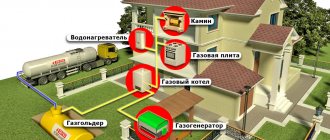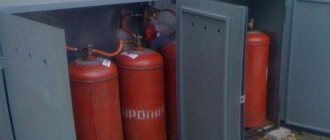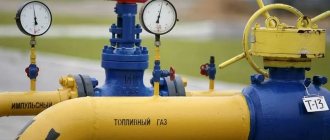The average gas consumption in a private house or apartment is usually calculated to determine the cost of heating, hot water supply (DHW) and cooking. This is done at the building design stage or before choosing an energy carrier and boiler unit for comparison with other types of fuel.
There is a simplified method for calculating the maximum and average gas consumption for heating and hot water supply, and it will be discussed in this material. Although it will not be possible to perform such a calculation with great accuracy, you will be able to find out the order of the numbers for the upcoming payment.
Calculation of gas consumption for heating
Before calculating the consumption of natural gas for heating a house or apartment, you need to know one important parameter - the heat losses of a residential building. It’s good when it is correctly calculated by specialists at the design stage, this will significantly increase the accuracy of your calculations. But in practice, such data is often missing, because few homeowners pay due attention to design.
Advice. If you have such an opportunity, then it is worth ordering a calculation of heat losses from a private design organization. This will help not only to find out the average gas consumption for heating a private house, but also to understand whether it needs to be insulated.
The amount of heat loss in a building is determined by the power of the heating system and the boiler itself or gas convector. Therefore, when selecting a gas boiler for a cottage or installing autonomous heating for an apartment, you have to use the following averaged methods for determining heat loss and equipment power:
- Based on the overall square footage of the building. The essence of the method is that heating each square meter requires 100 W of heat with a ceiling height of up to 3 m. At the same time, for the southern regions the specific value is 80 W/m², and in the northern regions the consumption rate can reach 200 W/m².
- Based on the total volume of heated premises. Here, 30 to 40 W are allocated for heating 1 m³, depending on the region of residence.
Note. The presented specific heat consumption is correct when the temperature difference between the street and indoors is about 40 °C.
It turns out that heating a home with an area of 100 m² requires about 10-12 kW of heat per hour during severe cold weather and when the house is located in the middle zone. Accordingly, for a cottage of 150 m², about 15 kW of thermal energy will be required, for 200 m² - 20 kW, and so on. Now you can calculate what maximum gas consumption a gas boiler will show on the coldest days, for which the formula is used:
V = Q / (q x efficiency / 100), where:
- V – volumetric flow rate of natural gas per hour, m³;
- Q – the amount of heat loss and power of the heating system, kW;
- q – the lowest specific calorific value of natural gas, on average 9.2 kW/m³;
- Efficiency is the efficiency of a gas boiler or convector.
Note. The efficiency of natural gas heat generators ranges from 84-96% depending on the design. The simplest non-volatile units have an efficiency of 86-88%, convectors 84-86%, high-tech condensing boilers - up to 96%.
Which boiler uses gas more economically?
Condensing wall-mounted boilers are considered the most economical today. Their productivity is close to 100% due to the extraction of additional heat from the formed condensate. Another thing is that such boilers are economical only with low-temperature heating systems. These include, for example, water heated floors. In other cases, such a boiler will work like a traditional one.
In second place you can place traditional wall-mounted boilers with a closed combustion chamber. Their productivity is already 90-93%. At the same time, productivity does not depend on external factors.
In third place are floor-standing boilers. Here the difference in productivity is from 50% to 90% (It is true that it is rare that a manufacturer writes honestly about the low efficiency of their boiler). Plus, such boilers are draft-dependent. Therefore, they require a complete, properly installed chimney.
Calculation example
As an example, it is proposed to take an apartment with an area of 80 m² in the central zone of the Russian Federation. To heat it in the coldest period, you will need 80 m² x 100 W = 8000 W or 8 kW. It is planned to install a modern condensing boiler using natural gas with an efficiency of 96%. Then the calculation of gas consumption for heating looks like this:
V = 8 / (9.2 x 96 / 100) = 8 / 9.768 = 0.91 m³/h
It is not difficult to calculate how much fuel is required per day: 0.91 x 24 = 21.84 m³. But to determine the cost of natural gas consumption, you need to know more realistic figures, for example, its average consumption in an apartment for the entire heating season. Since there are significant temperature fluctuations during this season, the average amount of fuel is expected to be half the maximum.
Then the average daily gas consumption for heating the apartment will be 21.84 m³ / 2 = 10.92 m³. All that remains is to multiply this number by the duration of the heating season; in Moscow it lasts 214 days: 10.92 x 214 = 2336.9 m³. Having made a monthly breakdown, it is easy to determine the cost of autonomous heating of an apartment.
To calculate the average gas consumption in an apartment, you can go another way. First, find out the gas consumption to produce 1 kW of thermal energy, and then multiply this value by 8 kW. The calculation formula for calculating the volume of fuel per 1 kW of heat is as follows:
v = 1 / (qx efficiency / 100), where v is the required volume in m³/h.
Accordingly, 1 / (9.2 x 0.96) = 0.113 m³/h, and for the entire apartment it will be 0.113 x 8 = 0.905 m³/h with a small error. Further calculations are carried out in the same way as described above.
Note. The amount of gas consumed by the gas stove and for hot water supply is not taken into account, which will be discussed later.
Pros and cons of installing a gas meter.
As in any other situation, installing this device has its advantages and disadvantages. The advantages include:
- saving gas in summer by using a gas water heater;
- payment only for those cubic meters that were used.
Among the disadvantages, consumers note the following factors: the high cost of gas meters, regular state verification of the device once a year costs about 350 rubles, and with a large family it is not possible to save.
Note!
Gas consumption metering devices are suitable for families with one to three people living in them. Only then will savings take place. If there are 3-5 residents in an apartment with a gas meter, you will have to overpay.
Gas consumption for hot water supply
When water for household needs is heated using gas heat generators - a water heater or a boiler with an indirect heating boiler, then to find out the fuel consumption you need to understand how much water is required. To do this, you can raise the data specified in the documentation and determining the norm for 1 person.
Another option is to turn to practical experience, and it says the following: for a family of 4 people under normal conditions, it is enough to heat 80 liters of water from 10 to 75 °C once a day. From here, the amount of heat required to heat water is calculated using the school formula:
Q = cm Δt, where:
- c – heat capacity of water is 4.187 kJ/kg °C;
- m – mass flow rate of water, kg;
- Δt is the difference between the initial and final temperatures, in the example equal to 65 °C.
For the calculation, it is proposed not to convert volumetric water consumption into mass consumption, but to assume that these values are the same. Then the amount of heat will be:
4.187 x 80 x 65 = 21772.4 kJ or 6 kW.
It remains to substitute this value into the first formula, which will take into account the efficiency of the gas water heater or heat generator (here - 96%):
V = 6 / (9.2 x 96 / 100) = 6 / 8.832 = 0.68 m³ of natural gas once a day will be used to heat water. To complete the picture, you can also add the consumption of a gas stove for cooking based on the norm of 9 m³ of fuel per 1 living person per month.
Is it necessary to install a meter in an apartment?
In the past, the law required installing a gas meter in the apartment. But recently it has become irrelevant. Those who use gas exclusively for cooking were exempted from the obligation to install meters.
The law states that if gas consumption is no more than 2.1 cubic meters per hour, installation of the device is not required.
Note!
Installation of a gas meter depends on the desires and capabilities of the owner.
Manufacturers produce several types of meters:
- rotary;
- membrane;
- electronic;
- volumetric.
Rotary: do not make noise, are checked every five years, are relatively inexpensive.
Membrane: a simple device, reliable, affordable, but they have some disadvantages - they make a lot of noise, are large, and require frequent checking.
Electronic: small size, high accuracy, silent, checked once every ten years. Quite expensive.
Volumetric: high-quality and inexpensive. Check once every ten years. Among the disadvantages, consumers note loud noise and large dimensions.
To make your choice, you need to consider important points:
- price;
- required level of noise emitted;
- device size;
- mounting location;
- required inspection frequency.
Note!
Gas meters can be installed both indoors and outdoors.
Many types of devices can withstand temperatures from low to high.
Here are some tips for choosing: if your apartment or house has a gas water heater or stove, then a rotary or electronic meter is better suited. If the house also has a gas boiler, then a volumetric or membrane meter is suitable. According to consumer market data, the most inexpensive device costs about 1,100 rubles. To mount the controller on two devices: a gas flow-through heater and a stove, the meter will cost approximately three thousand rubles. No installation fee.
Note!
In some cases, installation requires replacement of pipes or parts thereof at the location where the device is mounted. Also, before starting installation of the controller, a mounting diagram is drawn up.
An electronic meter is ideal for indoor installation. Most consumers choose it for its small size and noise level.
If you have a gas boiler and stove, it is better to choose a meter with a capacity of up to twenty-five cubic meters of gas per hour. If the stove only runs on gas, then a capacity of more than five cubic meters is not needed.
Note!
The installation of gas meters should only be carried out by workers with special education.
How to determine liquefied gas consumption
Heating a home using liquefied fuel (propane or butane) has its own characteristics. Most often, homeowners install special containers - gas tanks, which are refilled for the entire heating season. Heating using cylinders is much less common. But calculating the consumption of liquefied gas for heating a house does not present any particular difficulties.
The same formula is taken, only the specific heat of combustion of LPG (propane-butane) is substituted into it, equal to 46 MJ / kg or 12.8 kW / kg. Please note: the calculated calorie content of fuel refers to a unit of mass (kilogram), and at a gas station the price is calculated per volume (liters). The results can be recalculated later, first you need to find out the consumption of liquefied gas by a conventional boiler (efficiency - 88%) heating a house with an area of 80 m² from the previous example:
V = 8 / (12.8 x 88 / 100) = 8 / 11.264 = 0.71 kg/h.
Knowing that 1 liter of liquefied gas has a mass of 540 g (reference value), it is easy to calculate the propane consumption in liters: 0.71 / 0.54 = 1.3 liters. Per day this is 1.3 x 24 = 31.2 liters of gas, per month - 31.2 x 30 = 936 liters. Now, taking into account changes in weather conditions, to determine the average consumption of liquefied gas, the resulting figure must be halved: 936 / 2 = 468 liters per month. Gas consumption for heating per year will be (31.2 l / 2) x 214 days = 3338.4 l (for Moscow).
Calculation method for heat loss
In cases where a gas boiler has not yet been purchased, but there is a need to estimate future costs, gas consumption in a private home is calculated based on heat loss. In most cases, this indicator is already known to the owners. The principle of calculation in this case is as follows: we find 50% of the amount of heat consumed, add to it 10% for the ventilation system and the provision of hot water supply. In this way, the approximate heat consumption in kW/h is obtained.
By further multiplication, you can find out the values of gas consumption per day, per month or for the entire heating season. Having received the total value of heat loss, they need to be converted into cubic meters (the value of the specific heat of combustion of the fuel will be needed). Thus, once you determine the volume of gas consumed, it can be multiplied by the price and determine the total heating costs.
How to reduce gas consumption for heating and other needs
In this section we will talk about banal things that many have heard about. But banality does not make their importance any less. After all, this is a direct way to reduce the amount of energy used, including the high consumption of gas used to heat a private home.
The following measures will significantly reduce consumption:
- Carry out high-quality insulation of the building, preferably from the outside.
- If possible, automate the heating system so that the rooms of the house are well heated while people are in them, and in their absence, the standby temperature is maintained at 10-15 ° C.
- Use a timer for the indirect heating boiler so that the water in it is prepared at a certain time of day.
- Heat the house with water heated floors.
- Purchase the most economical gas boilers - condensing boilers.
All these measures will bring even more benefits and will reduce gas consumption if you yourself save. It may be possible to install automation only partially or not at all, then you will have to manage the system yourself. By the way, modern boiler controllers have built-in remote control functions via the Internet or cell phone.
How to measure flow
Unfortunately, in most articles posted on the Internet, calculation examples do not provide a clear answer to this question, and further confuse the average consumer.
The reason for this is the fact that such calculations are based on the power of the gas boiler that it produces over a certain period of time.
Power is measured in kilowatts (kW/h).
However, not all authors of articles clarify that in this case they mean thermal power, not electrical power, so for many users the value in kW/hour causes an association with electricity consumption.
It is much clearer and more common to measure the consumption and cost of natural gas in cubic meters (cubic m/h), and liquefied gas in kilograms (kg/hour). Knowing the gas consumption for a certain period of time and the current gas tariffs, you can easily calculate the approximate cost of heating your home.











